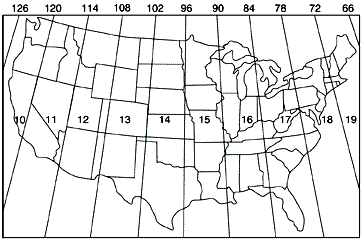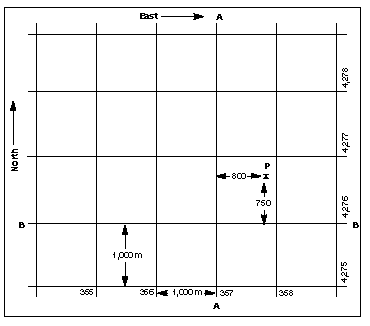|
About UTM Coordinates Map Projections These differences are due to the mathematical treatment required to portray a curved surface on a flat surface so that important properties of the map (such as distance and areal accuracy) are shown with minimum distortion. The system used to portray a portion of the round Earth on a flat surface is called a map projection. This grid is designed so that any point on the map can be designated by its latitude and longitude or by its grid coordinates, and a reference in one system can be converted into a reference in another system. Such grids are usually identified by the name of the particular projection for which they are designed. 
In this grid, the world is divided into 60 north-south zones, each covering a strip 6 degrees wide in longitude. These zones are numbered consecutively beginning with Zone 1, between 180 degrees and 174 degrees west longitude. Thus, the conterminous 48 states are covered by 10 zones, from Zone 10 on the west coast through Zone 19 in New England. In each Zone, coordinates are measured north and east in meters. (One meter equals 39.37 inches, or slightly more than 1 yard.) The northing values are measured continuously from zero at the Equator, in a northerly direction. Southerly values are similarly measured from the Equator, south. A central meridian through the middle of each 6 degree zone is assigned an easting value of 500,000 meters. Grid values to the west of this central meridian are less than 500,000 meters; to the east more than 500,000. Determining a UTM grid value for a map point The 1,000 meter value of the ticks is shown for every tick or grid line. In addition, the actual meter value is shown for ticks nearest the southeast and northwest corners of the map. Provisional maps at 1:63,360 scale show full UTM grids at 5,000 meter intervals. To use the UTM grid, you can place a transparent grid overlay on the map to subdivide the grid, or you can draw lines on the map connecting corresponding ticks on opposite edges. The distance can be measured in meters at the map scale between any map point and the nearest grid lines to the south and west. The northing of the point is the value of the nearest grid line; its easting is the value of the nearest grid line west of it plus its distance east of that line. On maps at 1:100,000 and 1:250,000 scale, a full UTM grid is shown at intervals of 10,000 meters and is numbered and used in the same way.
Graphics courtesy
USGS
The grid value of line A-A is 357,000 meters east. The grid value of line B-B is 4,276,000 meters north. Point P is 800 meters east and 750 meters north of the grid lines; therefore, the grid coordinates of point P are north 4,276,750 and east 357,800. Return from "UTM" to " Navigation"
|

